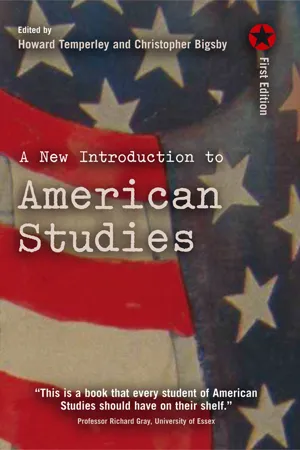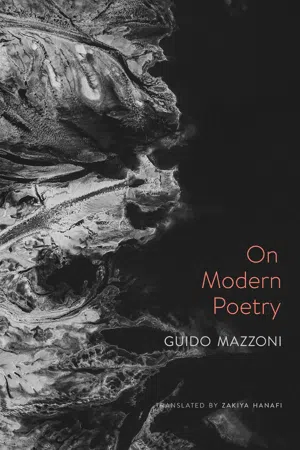Modern American Poetry
Modern American poetry refers to the diverse and innovative body of poetic work produced in the United States from the early 20th century to the present day. It encompasses a wide range of styles, themes, and voices, reflecting the cultural, social, and political landscape of America. Influential poets such as T.S. Eliot, Langston Hughes, Sylvia Plath, and Allen Ginsberg have contributed to the rich tapestry of modern American poetry.
6 Key excerpts on "Modern American Poetry"
- eBook - ePub
- Jacob Stratman(Author)
- 2016(Publication Date)
- Research & Education Association(Publisher)
...Although the literature’s content and form break with tradition in many ways, some writers use these new forms and taboo issues actually to attack modernity, exploring the growing tension between freedom and loss. In fact, some could assert that the modern era is one of fragments. America was changing in many wonderful ways, but its changes were also in conflict with its past; therefore, its art reflects this time of tumult and fragmentation. No longer are novels linear and chronological in nature. No longer are poems strictly narrative or lyrical. No longer are any artistic works easily interpreted. No longer is the truth of a text easily determined. Basically, modern art and literature do not directly state what they are; meaning, as stated earlier, is less important than mere existence. Modernism is laced with suggestion, metaphor, irony, ambiguity, understatement and subtlety, tone and tense shifts, and sometimes impenetrable prose. The common denominator for many of the modern poets is the literary journal Poetry: A Magazine of Verse. In 1912, Harriet Monroe founded and edited this poetry journal in Chicago that promised to introduce Americans to modern poetry. This “little magazine,” still in influential existence today, helped produce major writers through publications and reviews. Monroe single-handedly aided in the careers of Robert Frost, Carl Sandburg, Ezra Pound, T. S. Eliot, and William Carlos Williams, just to name a few. THE POETRY Amy Lowell (1874–1925) You should recognize this poet’s last name as the same as popular nineteenth-century poet James Russell Lowell. In fact, Amy grew up in a wealthy, educated, and prominent Boston family. Although she did not pursue higher education, Lowell dedicated much of her life to reading and writing poetry, culminating in her first collection of poetry in 1912. This collection was filled with traditional poetry influenced by English romantics...
- eBook - ePub
- Howard Temperley, Christopher Bigsby(Authors)
- 2014(Publication Date)
- Routledge(Publisher)
...Another author might take an entirely different tack, spending more time discussing, say, Edna Vincent Millay than Gertrude Stein. Another author might foreground the work of ‘minority’ poets while dismissing language poetry as hopelessly academic and distanced from any serious public. For critics averse to thinking about poets in groups, yet another history of twentieth-century American poetry might fruitfully be presented as a series of individual achievements independent of coterie affiliation — thus, instead of referring to ‘imagists’ it would focus on Pound; instead of ‘objectivists’ it could focus on Oppen; instead of ‘modernism’ it would focus on Wallace Stevens, and so on. Hundreds of well-known ‘avant-garde’ and ‘academic’ writers, including Jerome Rothenberg, Jack Spicer, Robert Bly, Sharon Olds, Gwendolyn Brooks, Cornelius Eady and Galway Kinnell, could have featured prominently here, but did not. This particular history is one among many. By whatever criteria, however, one thing all critics can agree on is that the twentieth century was a remarkable time for American poetry specifically and for world poetry generally. Further reading Algarín, Miguel and Bob Holman (eds), Aloud: Voices from the Nuyorican Poets Café (1994). Allen, Donald, The New American Poetry (1960, reissued 1999). Andrews, Bruce and Charles Bernstein (eds), The L=A=N=G=U=A=G=E Book (1984). Breslin, James, From Modern to Contemporary: American Poetry 1945–1965 (1983). Chang, Juliana (ed.), Quiet Fire: A Historical Anthology of Asian American Poetry, 1892–1970 (1996). Cruz, Victor Hernandez, Leroy V...
- eBook - ePub
The Challenge of Periodization
Old Paradigms and New Perspectives
- Lawrence Besserman, Lawrence Besserman(Authors)
- 2014(Publication Date)
- Routledge(Publisher)
...Nonetheless, it continues, for want of any alternative, since temporal generalization is incorrigibly necessary to discussion. Having said all this, I come to my topic, the periodization of Modem American poetry. The common periodization of American literature composes a nationalist story of manifest destiny, as I have said, in which the chains of empire are, after the colonial period, gradually cast off; a genuine indigenous literature in English arises, producing “major authors” in our “American Renaissance,” and swelling to greatness in the twentieth century, when “Modernist” novels and poems take the palm away from the parent tradition, as Eliot revolutionizes poetry and Faulkner places his unforgettable stamp on the novel. (A precisely comparable Irish story shows Yeats, Joyce, and Beckett in these supervening positions of de-colonizing power.) The fact that American literature is commonly described under only three periods (colonial and eighteenth century; the American Renaissance; and Modernism) means that the old form of periodization-by-sovereign familiar to us from English and French nomenclature has never been considered useful in the United States. It is difficult to imagine an anthology with a heading like “Literature in the Age of Millard Fillmore” or even “The Age of F.D.R.” Since we have undergone only three major historical events happening on our own soil—the American Revolution, the Civil War, and the Great Depression—we really haven’t a sufficient number of historical markers to delineate literary history with any finesse. Nor do we have a clear progression of governing ideas, or genres, though critics have made stabs at using ideas like manifest destiny, transcendentalism, and democracy to organize a narrative of literary production...
- eBook - ePub
- Richard Bradford(Author)
- 2005(Publication Date)
- Routledge(Publisher)
...Firstly, the poets who began writing in the late 1920s and 1930s were the inheritors of a literary tradition that included modernism, and as a consequence they felt able to draw both upon the stylistic innovation of their immediate predecessors and upon pre-modernist conventions. Secondly, the poets of this period initiated a change in the functional conditions of post-1900 poetry. Early modernist writing, particularly poetry, centred upon the individual consciousness as a means of perceiving, recording and communicating experience while remaining largely immune from the imperatives of order, judgement, classification or rational objectivity. The poetry of the thirties began to forge more tangible links between the individuality of the speaking subject and the broader social, political and existential conditions that the speaker shared with the implied reader—consider how Auden’s ‘In Memory…’ uses deictic clues to situate the condition of speaker and hearer as inhabitants of a continent on the brink of war. These two factors— stylistic eclecticism and a desire to reestablish poetry as a platform for social and political comment—resulted in compositional pressures that have effectively dominated British poetry between the 1930s and the 1980s...
- eBook - ePub
- Guido Mazzoni, Zakiya Hanafi(Authors)
- 2022(Publication Date)
- Belknap Press(Publisher)
...We identify with a speaker who gives value to a few fragments of life, known not for what they really were but for how the first person represents them, subjectively employing materials that come from a ritual use. Marked by this double expressivism, modern poetry evokes a personalistic and monadic image of the world: the center of the representation is not staged action between human beings or the telling of stories and their entanglements but the way in which an isolated speaker reports some experiences that are mostly individual, unrelated, intense, and instantaneous. No other genre, not even autobiography, is so egocentric in content and form; no other genre so easily eliminates the levels of reality that transcend the self, nullifying the presence of time, reducing the external world to landscape, separating the first person from the fields of psychic and social forces that traverse it, destroying the constraints that tradition and common sense place on anarchic self-expression. Even more inherently egocentric is the symbolic periphery of modern poetry, composed of works that efface content in order to focus the reader’s attention on the opaque beauty of words—because the moment there ceased to be any tradition limiting the play of individual talent, any style that displays itself and hides things ultimately expresses a vision of the world that is centered on the subject. But the other large periphery of our literary space, that of narrative and essay poems, does not escape lyricism of form either. The only kind of writing that the modern horizon of expectation judges to be servile and transparent is prose written in a simple style—not stories in verse, reflection in verse, or prose filled with figurative language. Modern poetry is the literary genre that most closely resembles the figurative arts of recent centuries. Like painting and sculpture, writing in verse has reacted with extremism to the crisis in mimesis and to the dehumanization of art...
- eBook - ePub
- John Timpane, Maureen Watts(Authors)
- 2011(Publication Date)
- For Dummies(Publisher)
...That tradition is as large and various as the country from which it comes. As China changes, so does its poetry. Following those changes will be one of the great pleasures of the 21st century. The Greats: Postmodern greats include Amiri Imamu Baraka, Robert Lowell, Elizabeth Bishop, Charles Olson, Allen Ginsberg, Frank O’Hara, John Ashbery, Basil Bunting, Ed Dorn, Gary Snyder, A.R. Ammons, Sylvia Plath, Anne Sexton, Robert Creeley, Adrienne Rich, Sharon Olds, Bob Dylan, John Lennon, Paul McCartney, Nicanor Parra, and Violetta Parra. Check out the following for a sampling of Postmodern poetry: The Harvard Book of Contemporary American Poetry, edited by Helen Vendler The New American Poetry: 1945–1960, edited by Donald M. Allen The Norton Anthology of Modern Poetry, edited by Richard Ellmann and Robert O’Clair The Pittsburgh Book of Contemporary American Poetry, edited by Ed Ochester and Peter Oresick PostModern American Poetry: A Norton Anthology, edited by Paul Hoover The Postmoderns: The New American Poetry Revised, edited by Donald M. Allen The Vintage Book of Contemporary World Poetry, edited by J.D. McClatchy Women’s voices The 20th century also saw important women emerge in poetry everywhere. Americans H.D., Marianne Moore, and Gertrude Stein were three great pioneers. Among the many extraordinary North American female poets of mid-century, we may include the work of Muriel Rukeyser, Lorine Niedecker, and Elizabeth Bishop. Other fine women poets are Russia’s Anna Akhmatova, Poland’s Wislawa Szymborska, Canada’s Margaret Atwood and Nicole Brossard, France’s Anne-Marie Albiach, China’s Shu Ting, and Japan’s Shiraishi Kazuko. South American poetry can boast of the work of Uruguay’s Delmira Agustini, Mexico’s Rosario Castellanos, and Chile’s Gabriela Mistral. And that’s just a start. Howling about Howl In the summer of 1955, ringleader Beat poet Allen Ginsberg wanted to write a fearless poem that would sum up his life...





